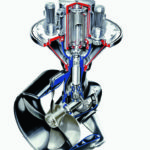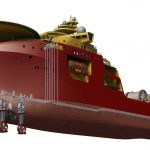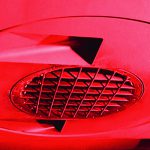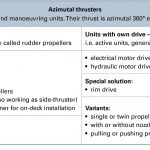For the first time, HANSA presents a market survey of what is called – in the widest sense – azimuth thrusters. Part one covers the passive units and part two in the next
issue the active units.
Talking about »azimuth thrusters« one should ask at first, is it a generic term or something else? With »360° azimutal[ds_preview] working thrusters« the whole world of units is described which are »two in one«. These units combine the two tasks: influencing the course of a vessel like a rudder and that of propelling it. Therefore, some manufacturers prefer the term »rudder propeller« for their products but they use it in most cases only in the stringent sense for their base product and not for their whole programme.
To make a procedure understandable one needs definitions. Thus, a first approach is made showing the correct generic term »azimutal thrusters« and the two general thruster groups, depending on their drive, called »passive« if without an own drive and »active« if equipped with an own integrated drive (see table on opposite page). The first part in this issue will cover the passive units, followed by the second part with the active units in the next issue.
The main variants of the passive azimuth thrusters are well- known since decades. It is the great contribution to ship propulsion technology of Josef Becker, the founder of the Schottel-Werft, to transfer consistently the effect of an outboard engine to the rudder propeller and developing high performance units to improve with them the manoeuvrability of all kinds of boats and ships, barges and pontoons. Today rudder propeller units are quite common for the power transmission up to 5,000 kW. For a certain time the top end of these thrusters was seen at this value as there were no high quality bevel gears available as needed for L- and Z-drives for higher power. The newest market survey shows rudder propellers with up to almost 10,000 kW. Stearprop offers units even beyond that. The mechanical limitation leads at the first glance to the distinction between rudder propellers and pods by the transferable power. But this is no distinguishing feature. There is a large overlapping in power for both groups.
Most manufacturers of rudder propellers have a programme with some standard models, which they modify according to customer specifications. Thus, a market survey is just general information to find out what might fit. One of the problems is the power quoted. If the companies only release the maximum transmittable power, there is no chance to find a suitable unit for unlimited operation. In some cases one will find even a remark that classified units will have reduced power rates.
Standard configurations
The standard configurations of rudder propellers form with their transmission shafts in the side view a Z or an L, independent from all other variants. But the two configurations have an important distinguishing feature and this is their drive. The L-drive needs of course a prime mover with a vertical drive shaft. This can only be an electric or a hydraulic motor. The big advantage of the L-drive is its very short construction, which saves space and avoids one bevel gear.
Schottel integrated the electric motor into the support tube of the thrusters and thus realised very compact units which combine, as the company says, the technical and economical characteristics of mechanical rudder propellers and pods. The company offers the so-called Combi Drives with one propeller and nozzle or twin propellers in the power range from 300 to 3,500 kW.
Small diameter and high efficiency
If the propeller diameter is the decisive measure for choosing a unit there are two possibilities to receive a small diameter: high-speed power transmission or twin propeller configuration. For a standard approach the power to transmit, the speed and the diameter of a propeller have to stay within a definite relationship with only small tolerances. Thus, if choosing high-speed rudder propellers for safe operation in shallow water one has to take into account a reduced efficiency of the propeller. The second solution uses two propellers either on one shaft turning both in the same direction or with separate shafts and contra-rotating propellers. However, the achievable efficiency is better with two small propellers than with a single propeller designed to transmit the same power.
Special variants
In contrast to most rudder propeller applications the retractable ones are normally not used for main propulsion. They are mainly used for dynamic positioning of offshore vessels. In a special version these units may be used in the retracted position as side thrusters, as this is offered, for instance, by Brunvoll with the trade name Combi Thrusters. Although not designed for main propulsion the retractable versions of rudder propellers offer in addition a very good take-home capability for different seagoing vessels. Very special products – under the generic term of azimuth thrusters – are the so-called cycloidal thrusters, better known as Voith-Schneider propellers. As they combine also in one unit the tasks of manoeuvring and propelling, they are by definition azimutal working thrusters. Voith Turbo produces them successfully since decades. The today’s programme reaches from 180 to 3,800 kW.
Another special product under the term used here are shallow water thrusters. Being controllable as well 360° azimutal they fulfil the same task as conventional rudder propellers. Originally designed as manoeuvring aid and propulsion unit for inland waterway and inshore vessels they are now used increasingly as a good solution for the required take-home capability of inland waterway cruise vessels. It goes without saying that these thrusters may also be used for dynamic positioning of vessels. Well-known specialists for shallow water thrusters are, for instance, the companies Jastram, Schottel and ZF Marine Krimpen. Jastram and ZF Marine Krimpen offer such units in about the same power range from 100 to 900 kW. Schottel already starts with only 49 kW and goes up to 3,500 kW. The thrusters will be flush-mounted in the hull generating only a very small resistance. The method of operation is simple: Water is sucked into the unit and – generating a high thrust – is pumped through a »rotating steering grid« (Jastram) or »outlet nozzles integrated into an animating base plate« (Schottel). The suction port is protected by a grid that can only be passed by small parts, which cannot damage the pumping element.
Some manufacturers offer thrusters classified with ice class, others developed special units for applications under polar conditions. As ice-breaking vessels are nowadays designed for astern ice breaking, special propulsion units are needed to get a powerful and durable drive. For such applications Wärtsilä developed rudder propellers functioning as pulling propellers, which will be supplied as classified with 1A super ice class and higher. The open fixed pitch propeller of these units are actively engaged in the ice breaking process by crushing even large ice blocks and flushing the ice. Besides vessels operating in the Baltic Sea in winter, Wärtsilä sees a great potential for vessels equipped with such rudder propellers operating on the Northeast Passage and along the Russian arctic coast cutting delivery time between Asia and Europe by one third. For the time being there are two units available: one for 1,750 kW and the other for 2,500 kW.
Hans-Jürgen Reuß




















